
|
|
ANTE UP: The Collection of Robert Eisenstadt |
|
|
We welcome you to take part in Ante Up, the auction of the Robert Eisenstadt's incredible collection. The auction takes place on January 30, 2021 at 10:00AM CT. You can visit the auction website by clicking here.
You can also view the collection that is up for auction as a PDF.
If you have any questions about the auction, please contact Joseph Slabaugh (joeslabaugh@potterauctions.com, 773-472-1442) at Potter & Potter Auctions.
|
|
|
IN MEMORIAM: Robert Eisenstadt 1942 - 2020 |
|
|
On June 5, 2020, Robert Eisenstadt died peacefully at home, in the loving presence of his sister Nancy and his sister's family. He will be dearly missed by all of us who loved and appreciated him. If you would like to leave a story about Robert, write a message, or read what others have written, please click here.
He took pride in his collection and loved sharing it with fellow enthusiasts; please have a look and enjoy.
|
|
Robert Eisenstadt's
Antique Gambling Chips &
Gambling Memorabilia Web Site
HOW TO DISTINGUISH BETWEEN (1)
BONE, (2) IVORY, AND (3) CELLULOID ("FRENCH IVORY," A PLASTIC)
I am amused the way flea market and antique dealers
often misrepresent (intentionally or not) the material of objects. If
a thing is white plastic or bone, it is often called "ivory." (If
it is colored plastic [or just about anything], it is often called "bakelite."
Click here for
someone's page about testing for bakelite. Click here
for my catalin/bakelite page.) I created this page as an aid
to those interested in identifying bone, ivory and celluloid. ...
....... Click here
for another good source on this subject.
(1) BONE CHIPS/COUNTERS
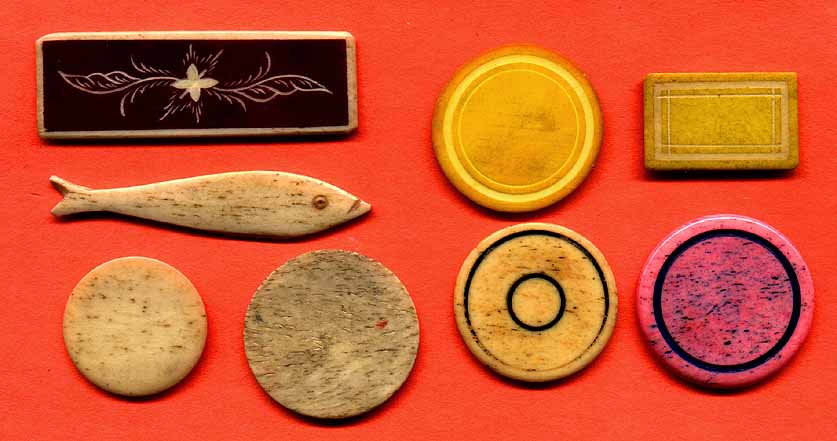
BONE CHIPS -- The
key distinguishing features of bone chips are the short, usually dark
(from soiling), porous cracks in the surface. They run in the same
direction. Many bone chips do not have the lines as pronounced as
in the samples above. Often they are hard to see, but look close, and
you should find them. Most (but not all) bone chips are not polished,
and are as thin as a dime or quarter. Compared to ivory, they are
light and weak. The two concentric bone chips at the lower right are
engraved, but most bone chips are not scrimshawed (engraved) -- usually they
are stained over the entire surface and then milled down to create the design.
Quite often the chips are stained one solid color and left that way -- yellow,
red, green, etc., or left natural (white). Usually the bone chips are
sold in sets of four colors (usually red, yellow, green and natural), each
color coming in its own small wooden box, and each color coming in three
shapes -- typically a circle, a long rectangle and a short rectangle (all
three shapes are shown in the above picture).
(2) IVORY POKER CHIPS
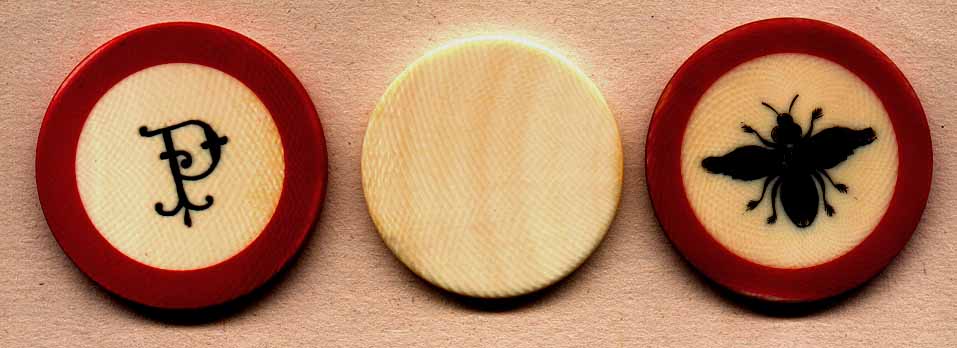
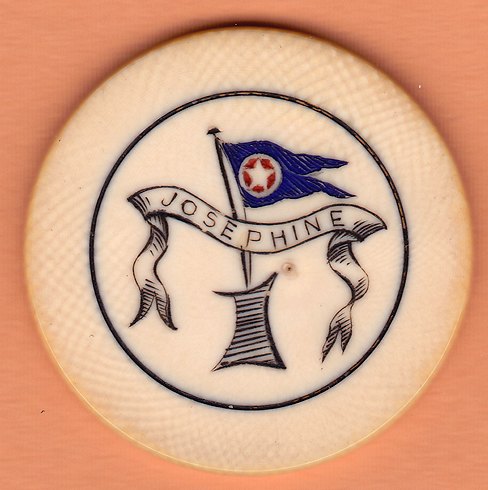
Many ivory chips do not show the ivory grain and nerve spot as conspicuously
as this one.
This chip is part of my wonderful set of ivories originally made for,
and owned by, the fabulously wealthy industrialist and philanthropist P.A.B.
Widener (1834-1915).
He kept it on his 225-foot yacht "Josephine," named after his wife. Full story
and pictures here.
IVORY CHIPS -- Ivory has curved grain
that intersects (cross-hatching). The samples above show this, but
are more pronounced than most ivory grain, which is often hard to see.
The best spot to find the grain is to look at the rim/end area of the chips.
Ivory is usually polished. It is heavier and stronger than bone.
Most ivory chips are about as thick as a poker chip -- about two quarters
thickness. Ivory chips are almost always scrimshawed (engraved)
with a design. (However, often concentric design ivories are not
scrimshawed, just stained near the rim.) (Also, remember that "ivory"
is a color as well as a material. I have an old wooden chip box
that has a label on it: "100 Checks 1-1/4 inch .... No.1.... IVOROYD."
The chips are clay composition. "Ivoroyd" referred to the color
or durability of the chips. I have often seen boxes of ordinary
plastic dice that had "ivory" rubber-stamped on the box. That simply
referred to the color of the dice.) (SEE IVORY FAKE SECTION AT BOTTOM
OF THIS PAGE.)
(3) CELLULOID (PLASTIC) CHIP AND DICE
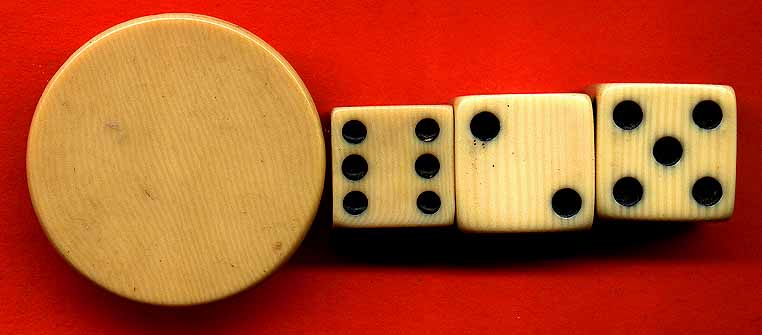
FRENCH IVORY/CELLULOID/PLASTIC CHIPS --
These chips are usually not made to fool people, just to make
inexpensive pleasing objects. Unlike the ivory chips, the grain
here is manufactured through the chips or dice as wavy PARALLEL lines.
That is the key -- the lines do not intersect or cross-hatch. Due
to the way they are manufactured, the dice have "grain" lines on four
sides, but none or not much on the other two sides (ends). These items
are plastic and burn easily and accept a hot pin readily. (French
Ivory is basically celluloid plastic with some ground powdered ivory mixed
in.)
IVORY FAKES (RECENTLY SCRIMSHAWED TO
LOOK OLD)
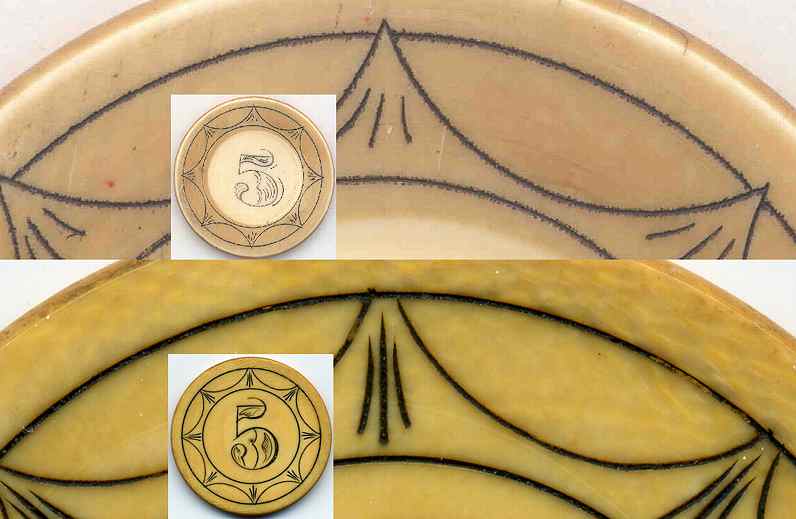
Recently some "ivory poker
chips" have appeared that were recently scrimshawed -- made to look
like antique ivory chips. One fake is shown above -- the top chip
is easy to identify by the jerky scrimshaw lines which were made by a laser.
A real old ivory chip is below it. I thank Richard Hanover for this
picture and the information. Rich says, "Each stroke that is carved
by hand starts with a blunt entry cut. The end of the curve is feathered
to a point as the steel leaves the ivory. Also, a hand carved lline is continuous.
The repro looks etched (scratched) or lasered. ... ....The sad part is
the the seller has plenty of buyers all thinking that they are getting
something they are not. " Others have said: "It sure doesn't look engraved
by hand. Looks more like it was blasted by a laser or even sandblasted.
The cuts aren't smooth and continuous like I'd expect from hand engraving.
... ... .... It is nice to see a close up of the line work. I am still not
covinced it is elephant tusk ivoy (as most all ivory chips from the 1800's
were elephant). With the look of straight bone pore lines in the new carving
chip, it looks like it might be walrus tusk to me."
There are other factors too in the difference between old antiue scrimshawed
ivory and the modern fakes: "Tusks used to make antique ivory chips were
crosscut. All of the modern repros being produced were cut lengthwise or
"ripped" in order to make as many blanks as possible." And some have suggested
that the rippled effect in the fakes, which are often recently scrimshawed
on old blank ivory, it that the old blank ivory is 10 times harder than when
originally taken form the elephant, so when scrimshawed today causes the
brittle point of contact as seen in the picture above.
Rich also made these comments regarding current machined ivory chips as
opposed to the old-fashioned carved ones: "A carved line will begin blunt,
where the knife enters the ivory, but end in a fine point, where the knife
leaves the ivory. Also, the design, being carved by hand, will not
be perfect. "A machined "scrimshaw" will fail on both points listed above.
A machine will begin and end a line with the same thickness. Also the symmetry
will be perfect."
|
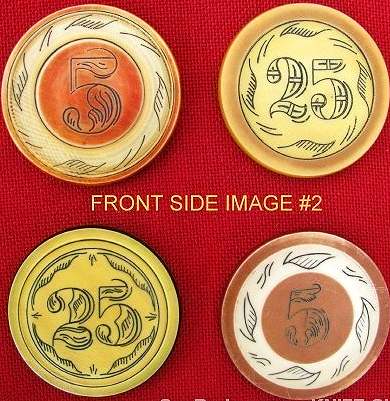
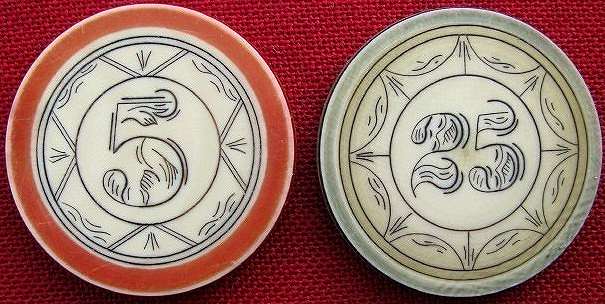 These are reproductions or fantasy (modern) ivory poker chips. Presented
that way on the seller's web site.
These are reproductions or fantasy (modern) ivory poker chips. Presented
that way on the seller's web site.
Home Page: ordering info.,policies
(satisfaction guaranteed, etc.), e-mail, etc.
Site Map







